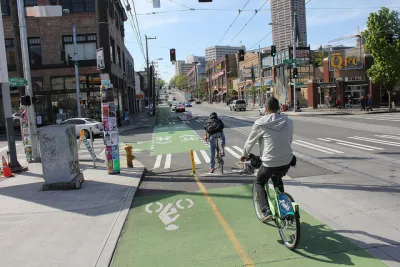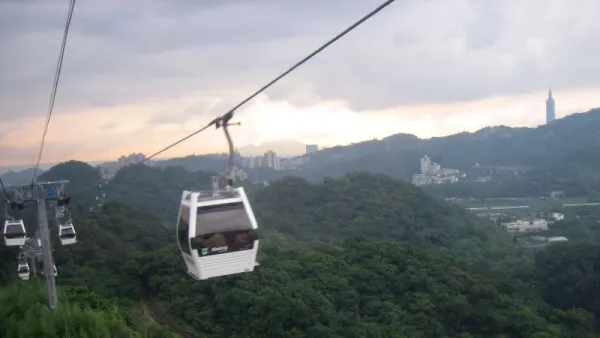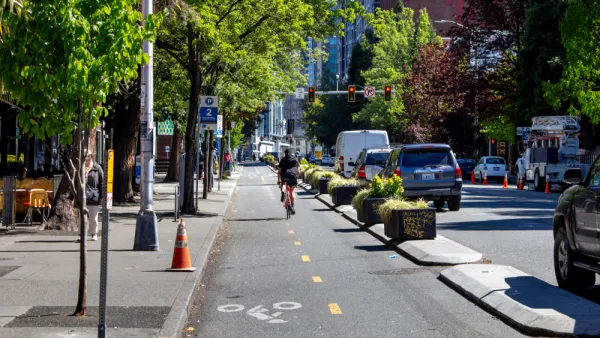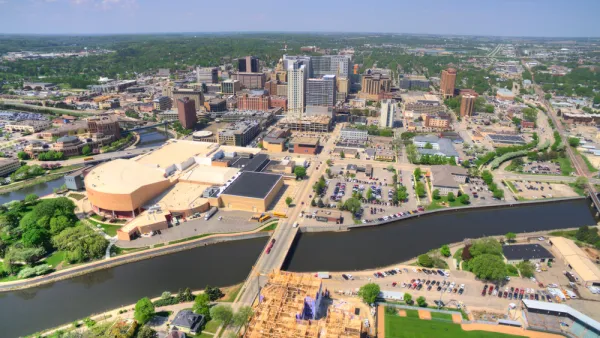By prioritizing a multi-modal approach and preserving existing vehicle space, the Seattle Department of Transportation risks abandoning the goals of its bicycle master plan.

The Seattle Department of Transportation (SDOT) is defending the decision to eliminate planned bike lanes on 35th Ave NE, arguing that removing the dedicated bicycle space will allow for more efficient transit movement through the area. SDOT Director Sam Zimbabwe blamed "outdated" modal plans that don't "play nice" with each other. The agency is developing a new framework for resolving conflicts between modes, but it's unclear where and how bike infrastructure will be prioritized.
So far, the proposed policy prioritizes pedestrians in "urban centers and villages," transit between neighborhoods, and goods movement in industrial centers. The bicycle network will receive priority "at critical connections" where it will "share priority with pedestrians," signaling support for multi-use paths and trails rather than dedicated bike lanes.
"From what I have seen, it’s mostly a way of preserving the status quo," said Anna Zivarts, a pedestrian advisory board representative on SDOT's Policy and Operations Advisory Group (POAG). Bryce Kolton, a representative from POAG's transit advisory board, echoed similar concerns, citing a reluctance on the part of the city to redistribute street space away from single occupancy vehicles. "Until they can tell me why established plans have not been completed when they aren’t for car traffic … I don’t think a multi-multimodal plan is the answer."
Ryan Packer, writing for Seattle Bike Blog, acknowledges that there are still a lot of questions about how a more multi-modal transportation plan will affect bike infrastructure, but with almost no space reallocated from vehicles to bicycles, the "skeletal" policies proposed within the new framework seem to walk back the more ambitious goals of the past.
FULL STORY: The end of the Bicycle Master Plan as we know it?

Analysis: Cybertruck Fatality Rate Far Exceeds That of Ford Pinto
The Tesla Cybertruck was recalled seven times last year.

National Parks Layoffs Will Cause Communities to Lose Billions
Thousands of essential park workers were laid off this week, just before the busy spring break season.

Retro-silient?: America’s First “Eco-burb,” The Woodlands Turns 50
A master-planned community north of Houston offers lessons on green infrastructure and resilient design, but falls short of its founder’s lofty affordability and walkability goals.

Test News Post 1
This is a summary

Analysis: Cybertruck Fatality Rate Far Exceeds That of Ford Pinto
The Tesla Cybertruck was recalled seven times last year.

Test News Headline 46
Test for the image on the front page.
Urban Design for Planners 1: Software Tools
This six-course series explores essential urban design concepts using open source software and equips planners with the tools they need to participate fully in the urban design process.
Planning for Universal Design
Learn the tools for implementing Universal Design in planning regulations.
EMC Planning Group, Inc.
Planetizen
Planetizen
Mpact (formerly Rail~Volution)
Great Falls Development Authority, Inc.
HUDs Office of Policy Development and Research
NYU Wagner Graduate School of Public Service




























